More small space?
The good news is that the project of the ultralight SS-520 suspended at the beginning of the year without financing will continue, and the second launch will take place between December and January. In parallel, in the other hemisphere, the ultralight Electron rocket is preparing for repeated tests. Sweden is considering the issue of converting a geophysical test site to a cosmodrome, there is a curious effect on the market for heavy geostationary satellites, and even the Strategic Command of the US Armed Forces wants other satellites. Cosmos "feel better"?
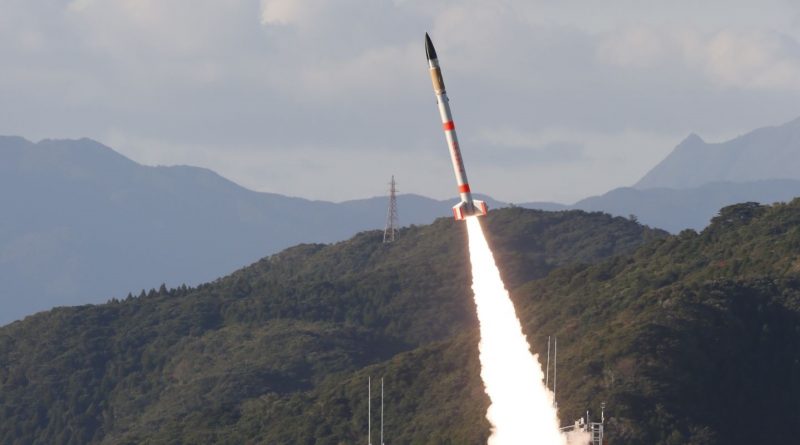
Start PH SS-520-4, photo JAXA
One of the easiest in the history of astronautics, the Japanese launch vehicle SS-520 was developed on the basis of a geophysical rocket ( for more details ). The first launch took place on January 14, 2017 and ended in failure - after 20 seconds of flight, telemetry disappeared from the rocket, the ground command post did not give the command to activate the second stage, and the payload rocket fell into the ocean. In less than a month, the cause of the accident was discovered. The fact that the last milliseconds before the disappearance of the signal became abnormal and went intermittently, made the onboard electrical system the main suspect. Engineers conducted an analysis and found a potentially weak spot between the second and third stages, where a bundle of cables entered a technical hole.
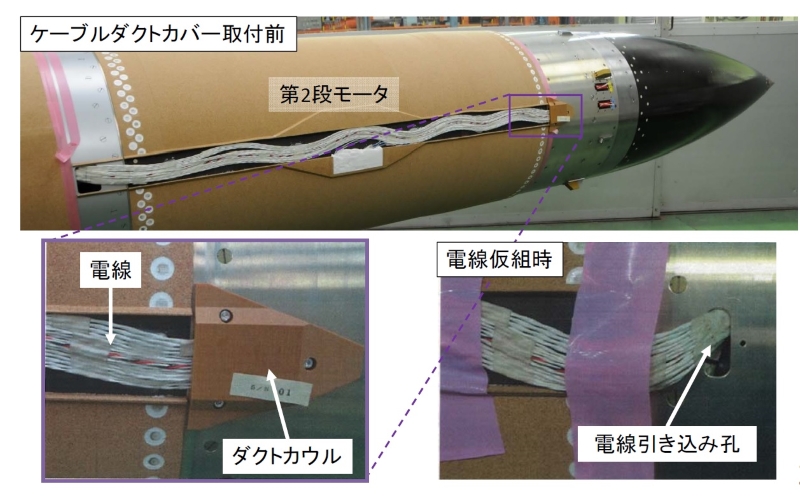
Suspect plot, JAXA photo
The cable was braided, but it could be damaged by vibration. To test the sample, the cable was installed in the shaker, applied the calculated tension and subjected to vibration similar to the flight. Depending on the vibration frequency, the insulation collapsed after 20-30 seconds.
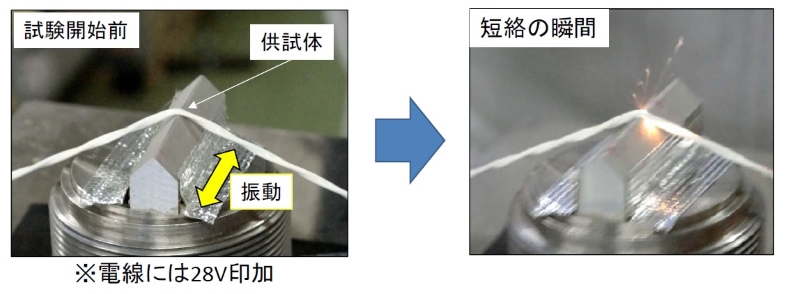
A natural experiment, photo JAXA
It was very easy to eliminate the malfunction, and various companies expressed interest in continuing the project. Therefore, the Japanese Space Agency decided to conduct a re-mission. According to the Nikkei, it will cost from 2.64 to 4.4 million dollars. The first experiment spent $ 3.5 million. But the extreme simplicity of the design should make this rocket cheap in mass production - on the SS-520, the control system is activated only between the first and second stages of operation, and the rocket must be stabilized by rotation for the rest of the time. A payload of ~ 4 kg will allow you to run one large Kubsat 3U or 4U or up to four small 1U.
The second launch attempt is scheduled for the morning of December 25, with the possibility of transferring to January 31, 2018. A cubic load of 3U (10x10x30 cm) TRICOM-1R for shooting the earth's surface, similar to that lost in the TRICOM-1 accident, will be a payload. Its creation is supported by the Ministry of Economy, Trade and Industry of Japan.
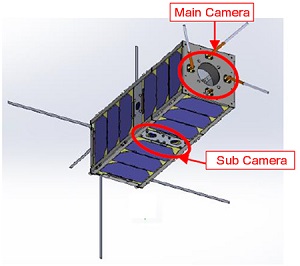
TRICOM-1R, drawing JAXA

PH Electron at the launch site, photo by Rocket Lab
At the end of May of this year, Electron's ultra-light launch vehicle crashed too for a foolishly offensive reason — one incorrectly installed toggle switch on the contractor’s equipment led to a loss of telemetry and a signal to crash the flight. Electron is heavier than SS-520, but also belongs to the ultralight class, its carrying capacity is 150 kg to a polar orbit or up to 225 kg to an orbit with an inclination of 45 °. The design of the rocket used interesting technical solutions - electric drive of pumps, 3D printing, composite tanks and the service of logistics of the head part ( more here ).
Unlike the first launch, when the layout was a payload, this time they will try to launch real satellites - one of the Planet Labs Dove (do not confuse - Rocket Labs makes the Electron rocket, and Planet Labs - the Dove / Flock satellites , no name fantasy ...) and two Spire Lemur-2 satellites. All three vehicles are cubic 3U, the rocket will fly underloaded, but if they are lost, the companies will not suffer serious damage.
The launch date has not yet been announced, but the rocket has already arrived at the cosmodrome, and the launch has been called “Still testing” (the first attempt was called “This is a test”). Approximately the start will be made in the coming weeks. A private space company has to be more active in promoting than the state agency, so the launch of Electron will be better covered than SS-520 No. 5.
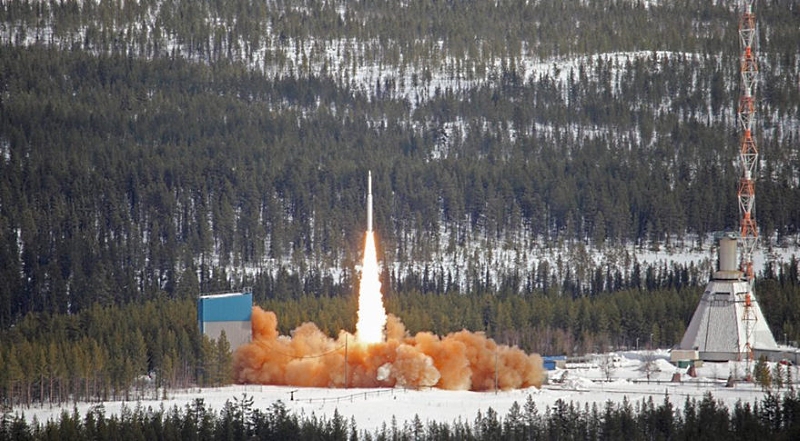
Esrange Space Center, Photo by the Swedish Space Corp
The Swedish government decided to assess the suitability of the expansion of the Esrange space center to a full-fledged cosmodrome. Located at 68 ° north latitude, the center was opened in 1966 and is engaged in launching geophysical rockets and atmospheric probes, as well as being used for communication with satellites. If it turns into a cosmodrome, it will become the northernmost in the world - Plesetsk 5 ° to the south. This makes it completely useless for the geostationary orbit, but now it can launch satellites into polar orbits as efficiently as any other space center. Conducting an assessment of suitability means that Esrange may not become a cosmodrome, but given the global interest in the microsatellite market, the chances of such an expansion are quite large. It is also too early to talk about what kind of launch vehicle will be launched there. In recent years, VSB-30 and Improved Orion geophysical rockets started from there, from the first one you can theoretically try to make a SS in the SS-520 style, but no one bothers to develop a new project.
Two more recent news related to the subject of light payloads. First, in a recent interview with SpaceX President Gwyn Shotwell said they noticed a failure in satellite orders to a geostationary orbit. Indeed, if earlier the norm was 20-25 orders for new satellites per year, the last two years this number has decreased, and in 2017 only 8 contracts were signed. No one knows whether this dip is temporary or whether there is a tectonic shift to the area of non-geostationary satellites. The recent success of Planet Labs or the sensational projects of hundreds of connected satellites from OneWeb or SpaceX are all non-geostationary groups.
Secondly, quite recently, the head of the Strategic Command of the US Armed Forces, General John Hyten, stated that he categorically dislikes heavy military satellites designed for a peaceful space environment and representing "big, fat, juicy goals." This does not mean that the general wants to arm them. No, in his opinion, it is necessary to develop groups of cheap small satellites that can survive the loss of several vehicles, and it will not be easy to destroy them. Anticipating possible comments, I will immediately say that the widespread opinion that it is possible to close an orbit with a “bucket of nuts” is not correct - a small separation of satellites in height and parameters of the orbit will require an irrational large number of “nuts” to destroy them.
Ultra-light launch vehicles lose in terms of the formal cost per kilogram into a more-lifting orbit. But the ability to launch a satellite at the right time into orbit with the right parameters can outweigh the financial loss of time spent waiting for an associated “big” satellite. Astronautics enthusiasts often dream of super-heavy rockets - only they can take enough cargo to move out of low-Earth orbit. Such projects are being developed , but it is completely incomprehensible what the observed miniaturization of satellites will do to them. Whether super-heavy rockets will take thousands of satellites away or die out, yielding to ultra-light rockets (on which you cannot build a base on the Moon), the future will show.

Start PH SS-520-4, photo JAXA
SS-520 No. 5
One of the easiest in the history of astronautics, the Japanese launch vehicle SS-520 was developed on the basis of a geophysical rocket ( for more details ). The first launch took place on January 14, 2017 and ended in failure - after 20 seconds of flight, telemetry disappeared from the rocket, the ground command post did not give the command to activate the second stage, and the payload rocket fell into the ocean. In less than a month, the cause of the accident was discovered. The fact that the last milliseconds before the disappearance of the signal became abnormal and went intermittently, made the onboard electrical system the main suspect. Engineers conducted an analysis and found a potentially weak spot between the second and third stages, where a bundle of cables entered a technical hole.

Suspect plot, JAXA photo
The cable was braided, but it could be damaged by vibration. To test the sample, the cable was installed in the shaker, applied the calculated tension and subjected to vibration similar to the flight. Depending on the vibration frequency, the insulation collapsed after 20-30 seconds.

A natural experiment, photo JAXA
It was very easy to eliminate the malfunction, and various companies expressed interest in continuing the project. Therefore, the Japanese Space Agency decided to conduct a re-mission. According to the Nikkei, it will cost from 2.64 to 4.4 million dollars. The first experiment spent $ 3.5 million. But the extreme simplicity of the design should make this rocket cheap in mass production - on the SS-520, the control system is activated only between the first and second stages of operation, and the rocket must be stabilized by rotation for the rest of the time. A payload of ~ 4 kg will allow you to run one large Kubsat 3U or 4U or up to four small 1U.
The second launch attempt is scheduled for the morning of December 25, with the possibility of transferring to January 31, 2018. A cubic load of 3U (10x10x30 cm) TRICOM-1R for shooting the earth's surface, similar to that lost in the TRICOM-1 accident, will be a payload. Its creation is supported by the Ministry of Economy, Trade and Industry of Japan.

TRICOM-1R, drawing JAXA
"Still testing"

PH Electron at the launch site, photo by Rocket Lab
At the end of May of this year, Electron's ultra-light launch vehicle crashed too for a foolishly offensive reason — one incorrectly installed toggle switch on the contractor’s equipment led to a loss of telemetry and a signal to crash the flight. Electron is heavier than SS-520, but also belongs to the ultralight class, its carrying capacity is 150 kg to a polar orbit or up to 225 kg to an orbit with an inclination of 45 °. The design of the rocket used interesting technical solutions - electric drive of pumps, 3D printing, composite tanks and the service of logistics of the head part ( more here ).
Unlike the first launch, when the layout was a payload, this time they will try to launch real satellites - one of the Planet Labs Dove (do not confuse - Rocket Labs makes the Electron rocket, and Planet Labs - the Dove / Flock satellites , no name fantasy ...) and two Spire Lemur-2 satellites. All three vehicles are cubic 3U, the rocket will fly underloaded, but if they are lost, the companies will not suffer serious damage.
The launch date has not yet been announced, but the rocket has already arrived at the cosmodrome, and the launch has been called “Still testing” (the first attempt was called “This is a test”). Approximately the start will be made in the coming weeks. A private space company has to be more active in promoting than the state agency, so the launch of Electron will be better covered than SS-520 No. 5.
Rockets go north

Esrange Space Center, Photo by the Swedish Space Corp
The Swedish government decided to assess the suitability of the expansion of the Esrange space center to a full-fledged cosmodrome. Located at 68 ° north latitude, the center was opened in 1966 and is engaged in launching geophysical rockets and atmospheric probes, as well as being used for communication with satellites. If it turns into a cosmodrome, it will become the northernmost in the world - Plesetsk 5 ° to the south. This makes it completely useless for the geostationary orbit, but now it can launch satellites into polar orbits as efficiently as any other space center. Conducting an assessment of suitability means that Esrange may not become a cosmodrome, but given the global interest in the microsatellite market, the chances of such an expansion are quite large. It is also too early to talk about what kind of launch vehicle will be launched there. In recent years, VSB-30 and Improved Orion geophysical rockets started from there, from the first one you can theoretically try to make a SS in the SS-520 style, but no one bothers to develop a new project.
Trends?
Two more recent news related to the subject of light payloads. First, in a recent interview with SpaceX President Gwyn Shotwell said they noticed a failure in satellite orders to a geostationary orbit. Indeed, if earlier the norm was 20-25 orders for new satellites per year, the last two years this number has decreased, and in 2017 only 8 contracts were signed. No one knows whether this dip is temporary or whether there is a tectonic shift to the area of non-geostationary satellites. The recent success of Planet Labs or the sensational projects of hundreds of connected satellites from OneWeb or SpaceX are all non-geostationary groups.
Secondly, quite recently, the head of the Strategic Command of the US Armed Forces, General John Hyten, stated that he categorically dislikes heavy military satellites designed for a peaceful space environment and representing "big, fat, juicy goals." This does not mean that the general wants to arm them. No, in his opinion, it is necessary to develop groups of cheap small satellites that can survive the loss of several vehicles, and it will not be easy to destroy them. Anticipating possible comments, I will immediately say that the widespread opinion that it is possible to close an orbit with a “bucket of nuts” is not correct - a small separation of satellites in height and parameters of the orbit will require an irrational large number of “nuts” to destroy them.
Conclusion
Ultra-light launch vehicles lose in terms of the formal cost per kilogram into a more-lifting orbit. But the ability to launch a satellite at the right time into orbit with the right parameters can outweigh the financial loss of time spent waiting for an associated “big” satellite. Astronautics enthusiasts often dream of super-heavy rockets - only they can take enough cargo to move out of low-Earth orbit. Such projects are being developed , but it is completely incomprehensible what the observed miniaturization of satellites will do to them. Whether super-heavy rockets will take thousands of satellites away or die out, yielding to ultra-light rockets (on which you cannot build a base on the Moon), the future will show.
All Articles